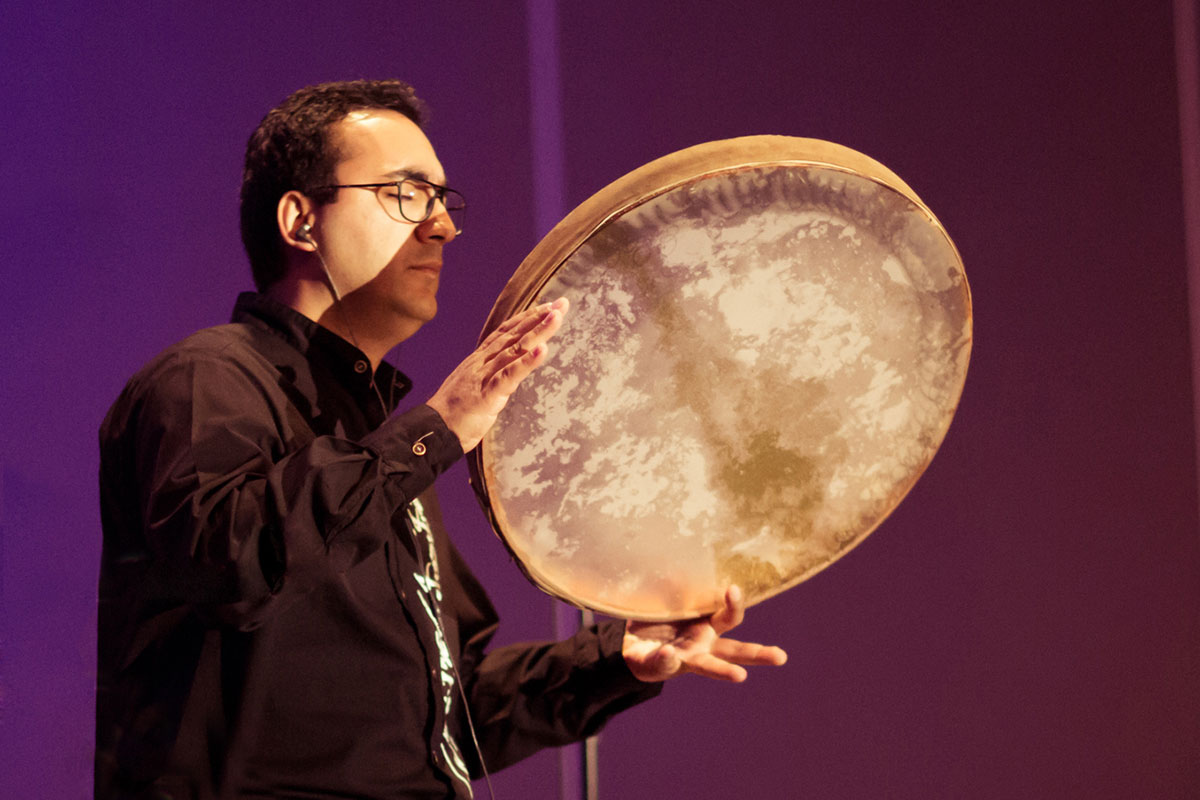From Kurdistan to Washington, Jalal Kimia Connects Communities with the Daf Drum

Photo courtesy of Jalal Kimia
In describing the sharp sound of the Kurdish frame drum, percussionist Jalal Kimia recalled the voices of veteran Sufi dancers. “The hoarse bass of the daf sounds like an old dervish who has many years of experience, in-depth insight, and perspective. As we say in Farsi, it is a plank of dry wood with a tender heart.”
The daf is part of the family of frame drums found throughout the world. In design, it is similar to the Italian tamburello and the Arabian bendir, but the rows of linked metal rings inside the frame account for its unique sound. Kimia spoke of the instruments’s origins after his interactive drumming workshop at the 2023 Smithsonian Folklife Festival on the National Mall.
“The daf comes from Kurdistan”—a geocultural region encompassing parts of Iraq, Turkey, Syria, and Iran—“but it is humans who draw the line, construct borders, and categorize cultural phenomena,” Kimia reminded. Reliefs and engravings reveal musicians played the daf in ancient Babylonia and Assyria, in a time predating Islam. Today, the daf is recognized as a Middle Eastern or Persian instrument.
Kimia believes that because frame drums are popular everywhere and “rhythm is the expression of our emotions,” percussionists can innovate on the daf by adding rhythms usually reserved for other drum traditions. In fact, it happened during his Festival workshop. After he taught visitors basic rhythms, he said, they played the daf like professionals. Its versatility is one of Kimia’s favorite qualities of the instrument.
Camera: Ali Ali, Nadya Ellerhorst
Editing: Nadya Ellerhorst
Kimia—who identifies as half Kurdish, half Persian—likes to introduce the daf and thus his culture to the Western world because he believes there is a mystical depth to the instrument capable of relaxing all who play it. The daf, he says, reveals this mysterious quality in a number of important settings. Historically, drummers played the daf to encourage warriors into battle. Nowadays, the daf is the fundamental instrument accompanying dancing at Kurdish weddings. Even in the West, feature film producers have used daf music in soundtracks, like the scene of the Afghan girl’s resurrection in The Breadwinner.
Yet music’s position within Islam is ambiguous. In Sufism, a widespread, mystical expression of Islam, followers believe in the power of music for good, hence instruments like the daf play a role. Sufi Muslims play daf in worshipful dance rituals, including those of the dervish—members of a Sufi fraternity known for their sacred dance. But some extremist Islamic clerics forbid the use of music, specifically joyful music. Other branches of Islam, even conservative forms, have accepted the daf. In Iran, drummers perform in Shia Moloudi ceremonies held in celebration of the Shiite Imams’ birthdays, or Imamate. Surprisingly, the Islamic government of Iran supports these ceremonies. Kimia pointed out that some Muslim branches that recite the Qur’an, Islam’s holy book, do so while performing on the bendir, a direct sibling of the daf. The ritual cannot be conducted without the percussive accompaniment.
At the Folklife Festival, Kimia taught visitors the drum rhythm for a form of prayer called dhikr (“remembrance”), repeated chants that are spoken during dervish temple rituals. The ritual begins with the rhythm or Magham, called “Hey-Allah” (هی الله), and as the rhythm changes, dervishes receive higher spiritual affirmation, until they begin a dance of worship called sama. When one performs this rhythm, Kimia said, “It is like the daf itself sings ‘Hey-Allah.’”
Kimia learned the daf in Iran. After moving to the United States in 2012, he founded the Rumi Daf Ensemble to spread this music and to preserve it in the diaspora. The group sings the poems of the Iranian poet Rumi while playing the daf at festivals and other events. Still, he believes the instrument is unfamiliar in the United States, even among Iranians.
“When you talk about the daf, they think it is only to dance to at weddings,” he said.

So Kimia decided to redirect his energy toward teaching the daf, through Percussion Academy classes and free Daf Circles at the Iranian-American Community Center in Vienna, Virginia. Today, both Iranians and non-Iranians number among his students. He says that all have the potential to learn, perform, and reach calmness and meditation. To introduce daf to students and audiences from different nations, he frames it as a form of folk music.
“Folk is direct, like the way you are with your intimate friend,” he defined. “Folk is the female Kurdish singer who dances Saghezzi [a Kurdish dance] and performs daf at her sister’s wedding. I like to teach daf by not drawing lines or borders or adding guitar or bass to attract more people, but to teach through the folk rhythms and personality found locally.”
One of his students, a Kuwaiti American woman named Roohi, speaking Farsi, recalled that at a single daf event at the University of Maryland, she found the sense of calmness that she lacked. She calls the community of daf students a family, although participants are of different ages, genders, and backgrounds. She talked about the high level of enthusiasm students and band members express while waiting for their weekly practice with Kimia.
During Kimia’s Festival workshop, two German visitors became fascinated by the daf and sat in to learn the rhythms. Encouraged, Kimia remarked on the daf’s potential to connect people from different backgrounds if it could reach broader audiences.
“This instrument comes from a big family—frame drums—and we, humans, are a family. Daf belongs to everyone, and everyone can play it.”

Zahra Abedinezhad is a doctoral candidate in comparative studies and folklore at The Ohio State University. As a 2023 summer intern in the Ralph Rinzler Folklife Archives, she conducted fieldwork on Persian representation at the Smithsonian Folklife Festival.

